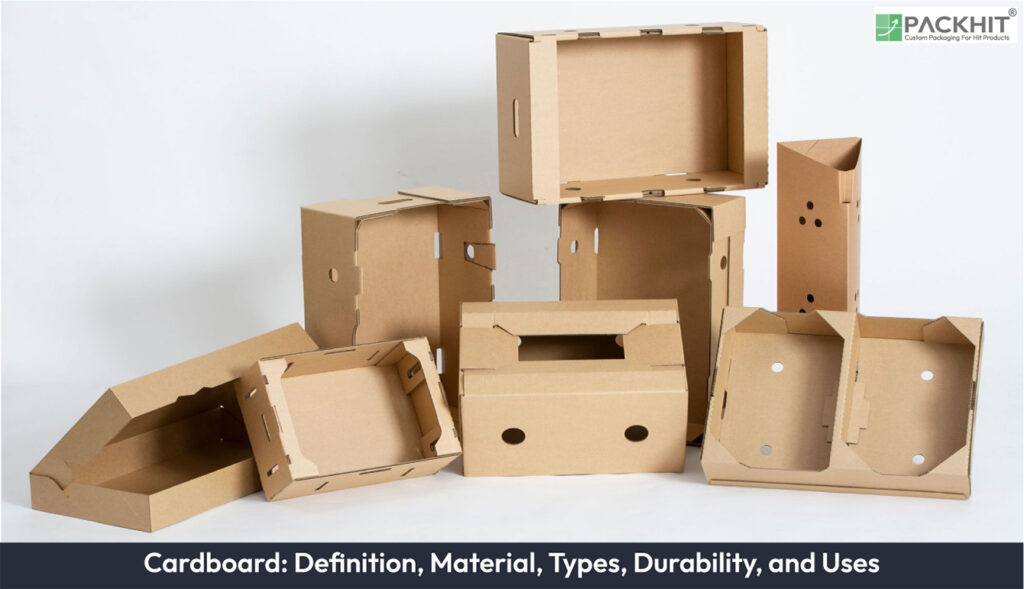Cardboard is a thick, paper-based material made from wood pulp or recycled paper, mainly used for packaging and storage. It is lightweight, durable, biodegradable, and cost-effective. Common types of cardboard include solid fiberboard for strong packaging, duplex board with a smooth surface for printing, and grey chipboard for crafts. Cardboard is made by pulping raw materials, forming sheets, and cutting them into shapes. It’s easy to recycle, customizable for branding, and decomposes quickly, making it eco-friendly. Cardboard is widely used in boxes, retail packaging, crafts, and recycling programs.
What is Cardboard?
Cardboard is a heavy-duty paper-based material designed for packaging and storage. It is characterized by its stiffness, lightweight nature, and ability to be recycled multiple times. First developed in 1817, cardboard has evolved into a versatile commodity used across industries for its affordability and environmental benefits.
What are the Properties of Cardboard?
Cardboard has various properties, including durability, recyclability, biodegradability, customizability, and cost-effectiveness.
- Durability: Cardboard is moderately durable, making it suitable for light items but less ideal for heavy loads.
- Recyclability: It is highly recyclable and can be processed up to seven times without significant quality loss.
- Biodegradability: Cardboard decomposes naturally in soil within 3 to 6 months, making it eco-friendly.
- Customizability: It can be easily printed and shaped to display branding, instructions, or warnings.
- Environmental Impact: Cardboard has a low environmental impact and supports sustainable packaging practices.
- Affordability: It is a cost-effective packaging solution compared to many other materials, like plastic.
What are the Types of Cardboard?
Cardboard comes in various forms, each suited to specific applications. Below are the primary types:
1. Solid Fiberboard
Solid fiberboard is a dense, single-layer cardboard used for heavy-duty packaging. It offers high stiffness and structural integrity, making it ideal for shipping fragile items.
2. Duplex Board
Duplex board features a clay-coated surface, providing a smooth finish for printing. It is commonly used for retail packaging and branding purposes.
3. Grey Chipboard
Grey chipboard is a lightweight cardboard often used for crafting and lightweight packaging. It is less durable but highly customizable.
How is cardboard made?
The production of cardboard involves several steps, transforming raw materials into a versatile packaging solution:
1. Pulping
Wood pulp or recycled paper fibers are processed to create a slurry. This forms the base material for cardboard.
2. Sheet Formation
The slurry is spread into thin sheets and dried to form the cardboard layers. Additives may be included to enhance stiffness or printability.
3. Cutting and Shaping
Cardboard sheets are cut and shaped into desired dimensions, ready for use in packaging or crafting.
What are the Benefits of Cardboard?
Cardboard offers several benefits, making it a preferred choice for manufacturers:
- Recyclability: Promotes environmental sustainability and reduces waste.
- Affordability: Significantly less expensive than plastic or metal packaging.
- Customizability: Easy to print branding, warnings, or product information.
- Biodegradability: Decomposes quickly, reducing long-term environmental impact.
What are the disadvantages of cardboard?
Despite its advantages, cardboard has certain limitations:
- Durability: Low; prone to tearing or crushing under heavy loads.
- Water Resistance: Not waterproof; unsuitable for moisture-prone environments.
- Methane Emission: Releases methane during decomposition, contributing to global warming.
What are the Uses of Cardboard?
Cardboard is widely used across industries for its versatility and cost-effectiveness:
1. Packaging
Cardboard is the go-to material for packaging due to its lightweight nature and customizability. It is used for shipping boxes, retail packaging, and protective inserts.
2. Crafting
Cardboard is a popular choice for crafting projects, including model-making, displays, and DIY decorations.
3. Recycling Programs
Cardboard is a valuable commodity in recycling programs, reducing waste and creating new fiber-based products.
What is the environmental impact of cardboard?
Cardboard supports sustainable practices but has environmental implications:
- Positive Impact: High recyclability and biodegradability reduce waste and promote sustainability.
- Negative Impact: Methane emissions during decomposition contribute to global warming.

